SWT/KWS RIFT VALLEY MOBILE VETERINARY UNIT


JUNE 2023

Introduction
15 Cases in June
June Report by Dr. Titus Kaitho

5 Giraffe Cases

5 HWC Cases
The Lake Naivasha Region and several parts of the Central Rift Conservation Area received seasonal rains during the reporting period. The Rift Valley Mobile Veterinary Unit attended to 15 Cases in total in June. These included 1 lion case, 1 waterbuck case, 1 security dog case, 1 buffalo case, 5 masai giraffe cases, and 6 common zebra cases.


Acknowledgement
We sincerely thank Sheldrick Wildlife Trust (SWT) and FIGS for their support and sponsorship. We also acknowledge Angela Sheldrick, CEO -SWT for her unwavering support and interest in the work undertaken by the Mobile Veterinary Unit. Additionally, we acknowledge the Wildlife Research & Training Institute (WRTI) for hosting the Rift Valley Mobile Veterinary Unit. We also thank all stakeholders and scouts who reported wildlife in distress. Thank you all.
Case Details
Date Species Area Found Reason for Intervention Outcome 02-Jun 23 Waterbuck Sirocco Farm Snared Adult female waterbuck with a wire snare around the neck Successfully treated. 05-Jun 23 Security Dog WRTI Canine Unit Natural Causes Lameness on left front leg Successfully treated. 05-Jun 23 Buffalo Moi Ndabi Farms HWC Translocation of an adult female buffalo that had strayed into maize farms. Task successful. 08-Jun 23 Lion Soysambu Conservancy Collaring Collaring an adult lioness in Soysambu Conservancy to mitigate HWC. Task successful. 09-Jun 23 Giraffe Nini Farm HWC Lame masai giraffe calf Successfully treated. 09-Jun 23 Zebra Soysambu Conservancy Snared Adult female common zebra wounded by a wire snare on the left hind leg Successfully treated. 11-Jun 23 Zebra WRTI Main Campus Natural Causes Lame adult male common zebra Successfully treated. 12-Jun 23 Giraffe Hell’s Gate N.P. HWC Adult male masai giraffe trapped between hot-geothermal gas pipes. Died. 19-Jun 23 Zebra Elsamere Natural Causes Lame male common zebra foal Successfully treated. 22-Jun 23 Zebra Marula Estates Natural Causes Adult female common zebra with a fracture on the hind leg. Died. Euthanized. 22-Jun 23 Zebra Marula Estates Natural Causes Lame male common zebra foal Successfully treated. 22-Jun 23 Giraffe Oserengoni Sanctuary Natural Causes Female masai giraffe calf wounded on the abdomen Successfully treated. 26-Jun 23 Giraffe Nini Farm HWC Follow-up treatment on the lame female maasai giraffe calf treated on 09/06/2023 Successfully treated. 27-Jun 23 Giraffe Ihindu Farm HWC Adult female masai giraffe with a large wound on the left hind leg. Successfully treated. 27-Jun 23 Zebra Green Park Estate Natural Causes Lame adult female common zebra Successfully treated.
June


Rift Valley Mobile Vet Unit Treatment
SWT/KWS
Locations
2023
Waterbuck Snared Olerai/Sirocco Farm
This adult female waterbuck had a wire snare around the neck
Immobilisation, examination and treatment
The waterbuck was immobilized with 6 mg Etorphine and 80 mg Azaperone. The wire snare around the animal’s neck was removed. Fortunately, the waterbuck had only suffered minor lacerations on the neck. The wounds were treated then anaesthesia was reversed with 100 mg Naltrexone given intravenously and intramuscularly.

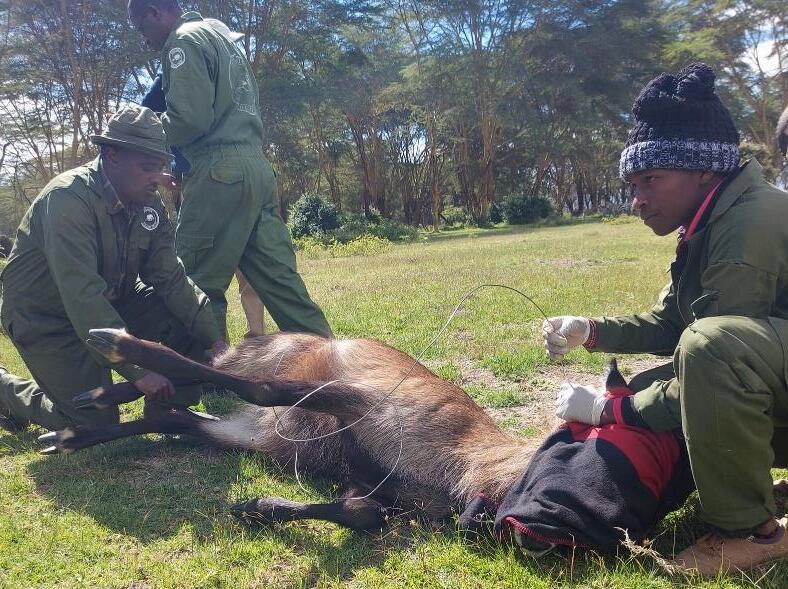

Prognosis
The waterbuck has a good prognosis.

– 02nd June
Case 1
2023
Case 2 – 05th June 2023
Security Dog
Natural Causes
WRTI Canine Unit
Rex, a Belgian Malinois security dog, had exhibited lameness on left front leg for 2 days

Immobilisation, examination and treatment
Rex was diagnosed with myalgia caused by a muscle injury Treatment was administered as follows:
i. PENISTREP 20/20 (Shanghai Gongyi Pharm – China) (Procaine benzylpenicillin 30000iu. Dihydrostreptomycin sulphate 300mg) 1.5mL (3/7 days)
ii. Colvasone® (Dexamethasone) 0.2%w/v sol inj. (Norbrook Labs – UK) 2mg by SQ route (1/7 days)
iii. Catasol® 5mL SQ for 3/7 days
His recovery after treatment was reviewed and found to be excellent.
Prognosis
Rex has a good prognosis.
Buffalo Human-Wildlife Conflict
Moi Ndabi Community Farms
The Naivasha Sub - County Senior Warden reported that an adult female buffalo had strayed into the Moi Ndabi Community maize farms.



Immobilisation and translocation
The dangerous animal was found roaming and grazing with cattle. It was immobilized with 8 mg Etorphine and 80 mg Azaperone. The buffalo was then loaded onto the bed of a pick-up truck and translocated, while under general anaesthesia, to the fenced Mundui Conservancy. Anaesthesia was reversed at the release site with 125 mg Naltrexone given intravenously and intramuscularly.

Prognosis
The translocation exercise was successfully executed. The buffalo has a good prognosis.
–
th June
Case 3
05
2023
Lion Collared Soysambu Conservancy
Kenya Wildlife Service approved the collaring of an adult lioness in Soysambu Conservancy. The Soysambu Conservancy lions are very elusive, they are not easy to spot and do not respond to call back stations. These lions live in a family of 3 females. There is no male lion in the Conservancy. The lionesses have a chequered history of preying on livestock in Soysambu Conservancy and its environs. Collaring these lions has been employed as a strategy to mitigate human-wildlife conflict, lion movement data transmitted by the collars is used to inform an early warning system for livestock - keeping communities.
Immobilisation, examination and collaring
Sina, the candidate for this collaring exercise, was captured in the same area the team had captured another member of the Soysambu pride on 18th July 2022 for a similar exercise. The lioness was darted with 300 mg Ketamine and 4 mg Medetomidine. The drugs took effect 20 minutes post-darting. The new collar provided by Soysambu Conservancy was fitted. 6,000 mg Amoxicillin was administered intramuscularly to counter capture stress. A fly repellent (Alamycin® Aerosal) was also topically applied on the darted site. Thereafter, anaesthesia was reversed with 250 mg Atipamizole 60 minutes post-darting

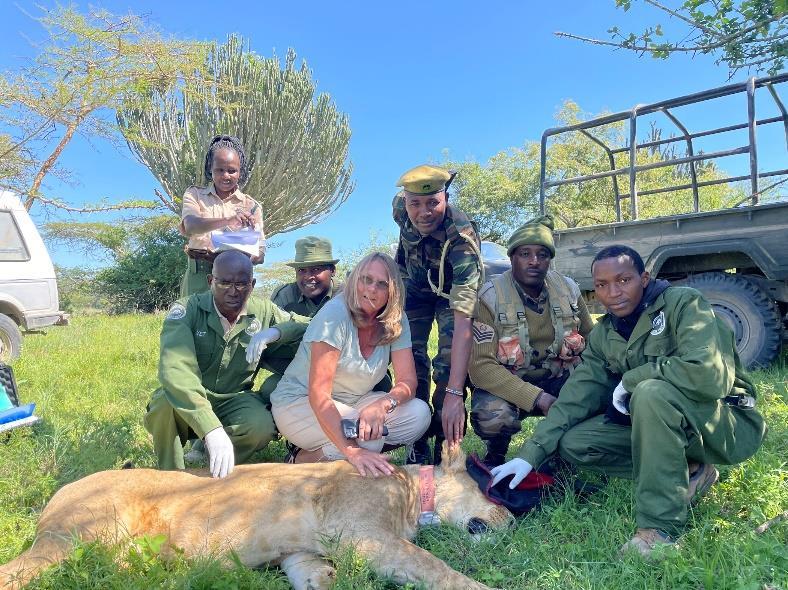

The collaring exercise was successful.
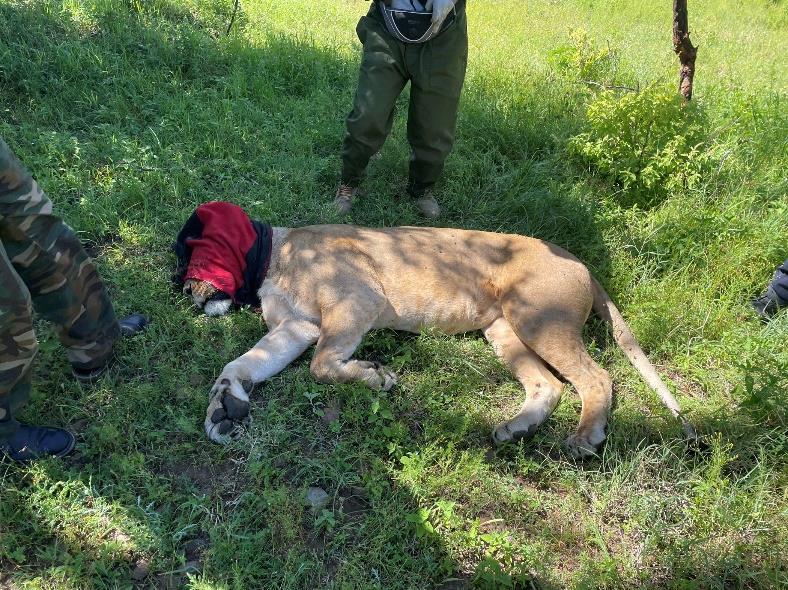
Case 4 – 08th June
2023
Giraffe Human-Wildlife Conflict Nini Farm
Nini farm staff reported seeing a lame masai giraffe calf.

Immobilisation, examination and treatment
The giraffe was immobilized with 6 mg Etorphine and 80 mg Azaperone. Upon physical examination, it was observed that the calf had a swollen and inflamed left hind leg. The giraffe had been wounded by a sharp object. The wound was cleaned with water, rinsed with Iodine then a fly repellent (Alamycin® Aerosal) was topically applied. 12,000 mg Oxytetracycline was administered to stop foot rot along with 250 mg Flunixin meglumine and 4 ml Ivermectin. Anaesthesia was reversed with 125 mg Naltrexone given intramuscularly and intravenously

Prognosis
The giraffe calf has a good prognosis.
Case 5 – 09th June 2023
Zebra Snared Soysambu Conservancy
The SWT-KWS De-snaring Unit reported an adult female common zebra wounded by a wire snare on the left hind leg.



Immobilisation, examination and treatment
The zebra was darted with 5 mg Etorphine and 80 mg Azaperone. The animal had a septic snare wound with purulent discharge on the left hind leg The snare was removed then the wound was cleaned with water and rinsed with Iodine before a fly repellent (Alamycin® Aerosal) was topically applied. 12,000 mg Oxytetracycline, 250 mg Flunixin meglumine and 30 ml Catasol were administered intramuscularly while 4 ml Ivermectin was administered subcutaneously. Anaesthesia was reversed with 75 mg Naltrexone administered intravenously and intramuscularly.

Prognosis
The zebra has a favourable prognosis.
Case 6 – 09th June 2023
Zebra
Natural Causes
WRTI Main Campus
While on patrol, the Rift Valley Mobile Veterinary Unit came across a lame adult male common zebra.


Immobilisation, examination and treatment
The zebra was immobilized with 5 mg Etorphine and 80 mg Azaperone. Upon physical examination, the animal was found to have a swollen and inflamed left hind leg. The zebra had suffered a fracture of the left hind leg. The digital leg bones were healing with mal – union. The zebra also had overgrown hooves and attendant foot rot. Hoof trimming and filling was done. A fly repellent (Alamycin® Aerosal) was applied on the healing wound. 12,000 mg Oxytetracycline was administered intramuscularly to stop foot rot. Additionally, 250 mg Flunixin meglumine and 5 ml Ivermectin were administered intramuscularly and subcutaneously respectively. Anaesthesia was subsequently reversed with 75 mg Naltrexone given intravenously and intramuscularly.


Prognosis
The zebra stallion has a good prognosis
Case
– 11th June
7
2023
Giraffe Human – Wildlife Conflict Hell’s Gate National Park
Hells Gate National Park management reported an adult male masai giraffe trapped between hotgeothermal gas pipes. The giraffe was found dead by the Vet Unit upon arrival.

Examination and disposal
The animal has accidentally fallen between hot geothermal gas pipes while trying to go across them The giraffe was trapped between three (3) hot geothermal gas pipes. It had suffered second degree burns and bruises as it struggled to free itself. The giraffe had vomited ingesta during this horrendous struggle. The carcass was buried in a grave dug with a JCB backhoe tractor provided by Or Power Ltd.
Recommendations
The geothermal power companies (KenGen Ltd. and Or Power Ltd.) shall clear vegetation along the geothermal gas pipes to ensure the pipes are visible to roaming wildlife.


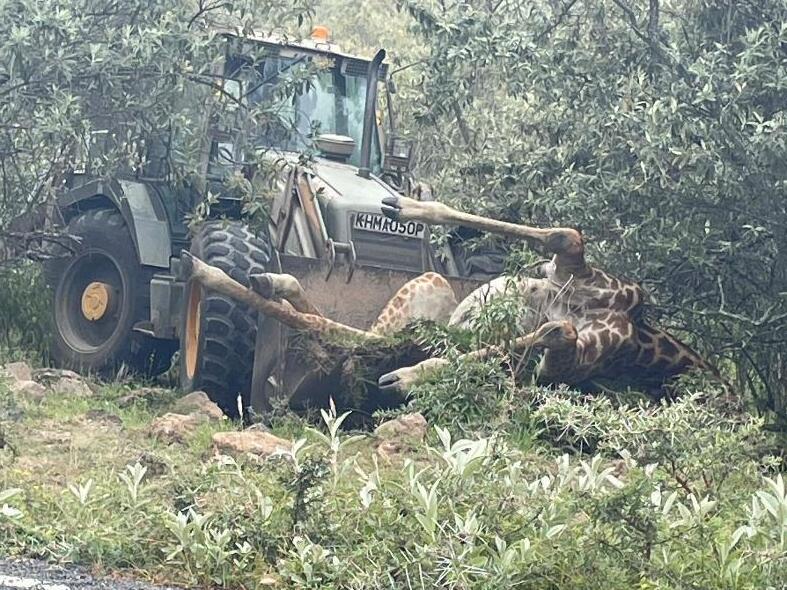
– 12th June
Case 8
2023
Zebra Natural Causes Elsamere
Elsamere staff reported seeing a lame male common zebra foal
Immobilisation, examination and treatment
The zebra foal was darted with 1.5 mg Etorphine and 5 mg Azaperone. The zebra was examined and found to have an injury at the hock joint that was healing well. However, the hock joint had fused and was immobile. The healing limb was brushing against the uninjured limb, this friction had resulted in a wound. This was the cause of the animal’s marked lameness. A fly repellent (Alamycin® Aerosal) was topically applied on the minor bruise then 3,000 mg Amoxicillin, 150 mg Flunixin meglumine and 20 ml Catasol were administered intramuscularly. 2 ml Ivermectin was also administered subcutaneously. Anaesthesia was reversed with 75 mg Naltrexone given intravenously and intramuscularly.

Prognosis
The zebra foal has a good prognosis.
Case 9 – 19th June 2023
Case 10 – 22nd June 2023
Zebra Natural Causes Marula Estates – Gilgil Turn Area
The KWS Senior Warden – Naivasha Station reported an adult female common zebra with a fracture on the left hind leg.


Immobilisation and examination
The zebra was darted with 5 mg Etorphine and 80 mg Azaperone. Upon physical examination, the zebra was found to have suffered an open complete fracture of the left hind leg. Prognosis of the case was poor. Therefore, the zebra was put to rest to alleviate further pain and suffering. The carcass was safely disposed of by burying in a pit
Prognosis
The zebra had a poor prognosis, it was put to rest to alleviate further pain and suffering.
Zebra Natural Causes Marula Estates – Gilgil Turn Area

The Senior Warden – Naivasha Station reported a lame male common zebra foal.
Immobilisation, examination and treatment
The zebra foal was immobilized with 5 mg Etorphine and 80 mg Azaperone. The foal had a swollen and inflamed left hind leg. It had suffered a fracture of the left hind leg at the lower hock joint. Given that the zebra was a young foal, there was a chance that the fracture would heal. The following drugs were administered to stop foot rot: 12,000 mg Oxytetracycline, 250 mg Flunixin meglumine and 5 ml Ivermectin. Anaesthesia was reversed with 75 mg Naltrexone given intravenously and intramuscularly.
Prognosis
The zebra foal has a favourable prognosis.
Case 11 – 22nd June 2023
Giraffe Natural Causes Oserengoni Wildlife Sanctuary


Kongoni Game Valley Staff reported a female maasai giraffe calf with a wound on the abdomen.


Immobilisation, examination and treatment
The giraffe was darted with 3 mg Etorphine and 40 mg Azaperone. The animal had suffered a wound on the abdomen which was maggot infested. It was believed that the wound was caused by a sharp object that was most likely a sharp piece of wood. The wound was cleaned with water, rinsed with Iodine, and sprayed with a fly repellent (Alamycin® Aerosal). 6,000 mg Amoxicillin and 250 mg Flunixin meglumine were administered intramuscularly while 4 ml Ivermectin was administered subcutaneously. Anaesthesia was reversed with 125 mg Naltrexone given intravenously and intramuscularly
Prognosis
The giraffe calf has a good prognosis.
Case 12 – 22nd June 2023
Giraffe Human-Wildlife Conflict Nini Farm
The Rift Valley Mobile Veterinary Unit performed follow-up treatment on the female maasai giraffe calf treated on 09th June 2023.



Immobilisation, examination and treatment
The giraffe was darted with 6.5 mg Etorphine and 80 mg Azaperone. Upon physical examination, the giraffe calf was found to have a swollen and inflamed left hind leg. The new wound was turning gangrenous, it was maggot infested and deep enough to expose bone tissue. The wound was cleaned with water, rinsed with Iodine, Opticlox® was applied on the open wound then a fly repellent (Alamycin® Aerosal) was applied topically. Additionally, 9,000 mg Amoxicillin, 250 mg Flunixin meglumine, and 40 ml Catasol were administered intramuscularly. 4 ml Ivermectin was also administered subcutaneously. Anaesthesia was reversed with 125 mg Naltrexone given by IV & IM route.
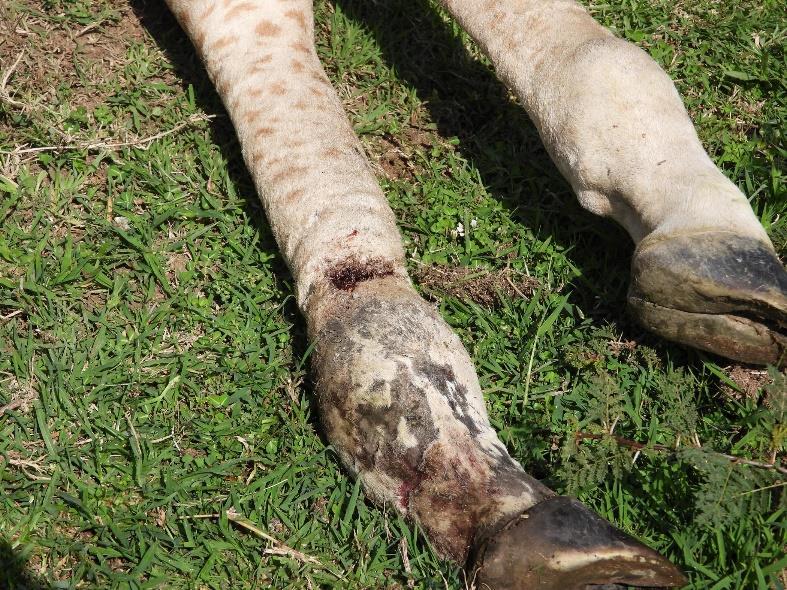
Prognosis
The giraffe calf has a guarded to poor prognosis.
Case 13 – 26th June 2023
Giraffe Human-Wildlife Conflict Ecoscapes Ltd (Ihindu farm)

This case was reported by the Ecoscapes property owner through KWS Naivasha Station.
Immobilisation, examination and treatment
The adult female masai giraffe was darted with 13 mg Etorphine and 80 mg Azaperone. It had suffered a large wound affecting parts of biceps femoris, semitendinosus and semimembranosus muscles of the left hind leg. The giraffe had been wounded by a sharp object that was most probably a machete. The wound was cleaned with water, rinsed with Iodine and sprayed with a fly repellent (Alamycin® Aerosal). 24,000 mg Oxytetracycline, 500 mg Flunixin meglumine, and 40 ml Catasol were administered intramuscularly. 8 ml Ivermectin was also administered subcutaneously. Anaesthesia was reversed with 250 mg Naltrexone given by IV & IM route. The giraffe was in poor body condition and aged. It was unable to stand. Therefore, supportive therapy was administered as follows: Glucose intravenous infusion BP 50% (w/v) - 100mL; Glucose intravenous infusion BP (50g/L) - 1000mL; NS-0.9 injection – 1000mL After 3 failed attempts to stand, 4 ml Adrenaline was administered intravenously. The giraffe stood 30 seconds later.



Prognosis
The giraffe has a guarded to poor prognosis.
Case 14 – 27th June 2023
Zebra
Natural Causes Green Park Estate
Green Park Security staff reported a lame adult female common zebra


Immobilisation, examination and treatment
The zebra was immobilized with 5 mg Etorphine and 80 mg Azaperone. Upon physical examination, the zebra was found to have been injured and wounded on left front leg. The wounds were on the caudal aspect of phalanx. One of the wounds that run deep into the joint was septic and had purulent discharge. The wounds were cleaned with water, rinsed with Iodine, and Opticlox® was topically applied. A fly repellent (Alamycin® Aerosal) was also sprayed topically. 12,000 mg Oxytetracycline, 250 mg Flunixin meglumine and 30 ml Catasol were administered intramuscularly while 4 ml Ivermectin was injected subcutaneously. Anaesthesia was reversed with 75 mg Naltrexone given intravenously and intramuscularly.
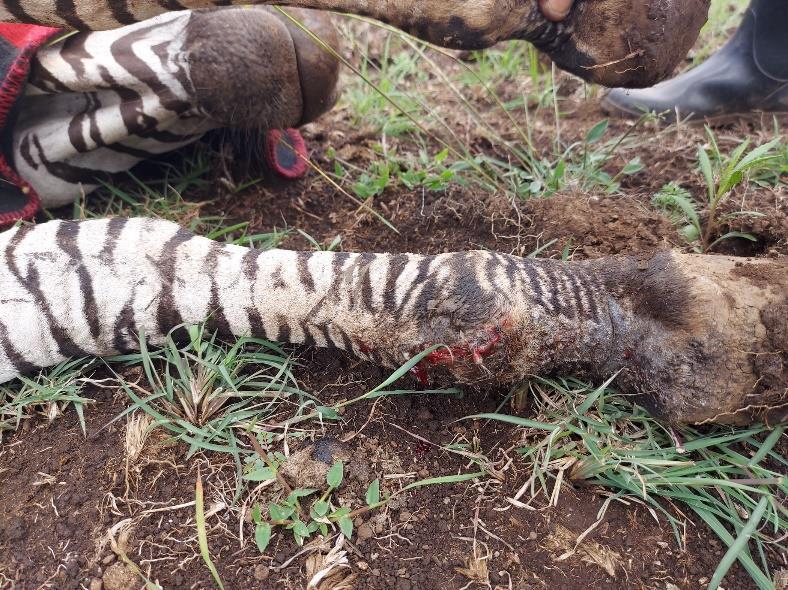

Prognosis
The zebra has a good prognosis.
–
June
Case 15
27th
2023























































